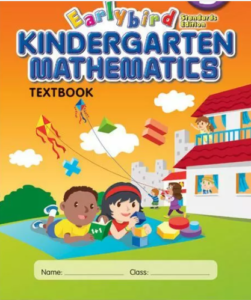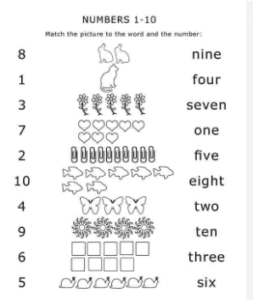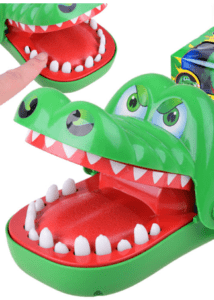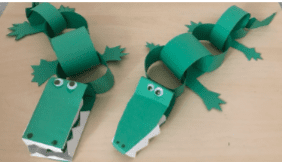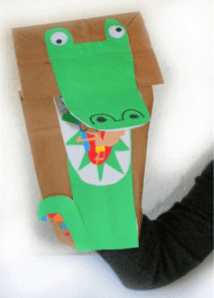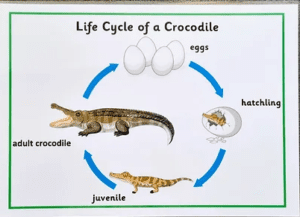Thematic Literacy Unit – Reproduction, Counting Numbers, and Visual Art
Lesson Plan Format
| VITAL INFORMATION | |
| Subjects (s) & Topic(s) Covered | Main Subject: Science
Topic: Reproduction
Integrated Subject I: Math Topic I: Counting Numbers Integrated Subject II: Art Topic II: Visual Art |
| Grade/Level | Pre-Kindergarten |
| Standard(s) | L.K.2: An understanding of how living things change in form as they go through the general stages of a life cycle. (Wright, et al., 2018, p. 21)
K.CC.3: Write numbers from 0 to 20. Represent a number of objects with a written numeral 0 to 20 ( with 0 representing a count of no object). (Wright, et al., 2016, p. 21) VA: Cr2.3.Ka: Create art that represents natural and constructed environments. (Wright et al., 2017, p. 23) |
| Objective(s) | The students will illustrate the crocodile’s life cycle by telling the cycle to the class with 95% accuracy. (Bloom’s Taxonomy)(DOK, 2)(Anderson et al., 2001)
The students will relate the number of crocodile’s teeth with the number name representing a specific sequence with 90% accuracy. (Bloom’s Taxonomy)(DOK, 2) (Anderson et al., 2001 The students will construct the visual arts of a crocodile with 70% accuracy. (Bloom’s Taxonomy)(DOK, 2) (Anderson et al., 2001 |
| Assessment/Rubrics | The teacher will evaluate the students’ recitations of the crocodile’s life cycle, where the students should be able to state the four cycles and provide details on what happens in each cycle.
The teacher will provide oral question and answer to assess the student’s ability to count and identify the appropriate number name representing the crocodile’s specified teeth numbers. Students should get a score of 9 out of 10. The teacher will encourage peer reviews, where the students will criticize their colleagues’ demonstration of the visual art developed based on their attractiveness and the art’s similarity with a real crocodile.
|
| Collaboration | The students work in small groups in making the visual arts. In the other two activities, the students will work independently. |
| Time Allotment | 50 minutes |
| Materials | Teacher Materials:
· Introduction text- ‘Watch Out for the Crocodile’ by Louise Ellis-Barrett · Mathematics text- ‘Earlybird Kindergarten Mathematics Textbook B’ by Winnie Tan and Yeap Ban Har. · Whiteboard · Dry-erase makers (2) · Projector (1) Student Materials: · Number worksheets (17) · Workbooks (17) · Art papers (17) · Scissors (6) · Pencils (17) |
| Resources & Research | Resources:
Mathematics textbook Number worksheet Crocodile teeth Crocodile paper puppet Crocodile paper puppet Life cycle of a crocodile Research:Anderson, L. W., Krathwohl, D. R., & Bloom, B. S. (2001). A taxonomy for learning, teaching, and assessing: A revision of Bloom’s taxonomy of educational objectives. New York: Longman. This article provides Bloom’s Taxonomy verbs used in the lesson plan objectives. Wright, C. M., Benton, K. S., Massey, J., Oakley, N., Clemons, W., Smith, T., . . . Sampsell, J. (2018). 2018 Mississippi College- and Career-readiness standards for science. Mississippi Department of Education, 1-133. Retrieved from https://www.mdek12.org/sites/default/files/documents/Secondary%20Ed/2018-ms_ccrs—sci_k-12_final_20171006.pdf This article by Wright et al. (2018) incorporates science standards into the life cycle and reproduction topic standards. Wright, C. M., Benton, K. S., Massey, J., Oakley, N., Dent, J., & Banks, M. (2017). Mississippi College- and Career-readiness arts learning standards for visual arts. Mississippi Department of Education, 1-85. Retrieved from https://www.mdek12.org/sites/default/files/MS%20CCR%20Arts%20Learning%20Standards%20for%20Visual%20Arts%202017%20FINAL.pdf This article provides visual art standards incorporated into the modeling activity. Wright, C. M., Benton, K. S., Massey, J., Oakley, N., Green, T., & Davis, M. (2016). 2016 Mississippi College- and Career-readiness standards for mathematics. Mississippi Department of Education, 1-236. Retrieved from https://www.mdek12.org/sites/default/files/Offices/Secondary%20Ed/Math/ccr%20for%20teacher/2016-MS-CCRS-Math_2.pdf The article by Wright et al. (2016)contains mathematics standards for various grade levels, which provide standards associated with counting numbers of objects. |
| IMPLEMENTATION | |
| Introduction/Anticipatory Set
(Pacing: _10_ minutes) |
The teacher will say, “Good morning?” The students will respond, “Good morning, teacher.” The teacher will say, “In today’s science lesson, we will read on reproduction. We will concentrate on the life cycle of a crocodile. The lesson will incorporate mathematics counting concepts and practice visual art modeling. Before beginning the class activities, pay attention to the story I will read to you.” The teacher will read an introductory story from the text ‘Watch Out for the Crocodile’ by Louise Ellis-Barrett. The teacher will say, “The text talks about crocodiles. The theme aligns with our science topic. A crocodile is a reptile that lives in water and on land. It has a life cycle of four stages: egg-hatching-juvenile-adult crocodile. I encourage your participation in the class activities .” |
| Procedures
(Pacing: _30_ minutes) |
I Do
The teacher will say, “As mentioned earlier, today’s lesson will integrate different centers in the science lesson, including math and art. Pay attention to the content I am projecting on the whiteboard.” The students will focus on the whiteboard as the teacher projects an illustration of the life cycle of a crocodile. The teacher will continue, “From the demonstration, let us brainstorm on key information captured about crocodiles.” The students will lift their hands while the teacher appoints one at a time to respond to the request. One student will respond, “A crocodile has four stages in its life cycle.” The teacher will remark, “Good work. That is the most essential point to note. Any other information?” the teacher will give students the chance to share details of the life cycle of a crocodile. The teacher will comment, “Great job. Having attained the basic knowledge of the growth cycle of the crocodile, let us work in a group of three on the art activity. We Do The teacher will say, “Using the paper and a pair of scissors, let us practice our art skills by modeling a crocodile puppet in your groups. Reach out to me for any support.” The students will integrate their art skills by sharing ideas on structuring the puppet. The teacher will walk around the class and evaluate how the students develop their puppets. The teacher will provide feedback as the students make relevant adjustments to achieve the desired visual art. After 10 minutes, the teacher will say, “You have five minutes to finish your activity.” The students will assemble their craft and present it to the teacher. The teacher will remark, “In our last activity, I advocate that each of you work independently to exercise mathematical counting skills.” You Do “Using the projected image of the crocodile, count the number of teeth on the lower and upper jaw and note that in your workbooks. Then, count the teeth of the crocodile on the sheet given. Note in your workbook the total number of teeth in each jaw. In the last step, you will write the name of all numbers to the name of the total number counter in each jaw.” The students will work independently to exercise their math skills on counting objects and representing them with the numbers. |
| Closure
(Pacing: _10_ minutes) |
The teacher will say, “Towards the end of the lesson, I recommend all for your participation and contribution to all the class activities. During the lesson, we have integrated three different learning aspects. I affirm that you have all learned how different subjects correlate and help develop multiple skills.” “We affirm that,” the students will respond. “The lesson activities are instrumental in academic skills development and reinforce the importance of building on hand skills.” The teacher will request the students criticize the crocodile paper puppets to help them understand their mistakes. |
| Differentiation: Remediation and Enrichment | Remediation:
The teacher will remark, “Students who encountered difficulties counting the teeth and representing them with the right number names, I will give them number worksheets to practice to improve their number knowledge with the support of your guardians.” Enrichment: “Some of the students require mastery materials to advance their knowledge. I will provide each with a mathematics textbook – ‘Earlybird Kindergarten Mathematics Textbook B’ by Winnie Tan and Yeap Ban Har, to interact with more complex problems with the guidance of your guardians. Also, the introductory text ‘Watch Out for the Crocodile’ by Louise Ellis-Barrett is an interesting text to enhance your creativity,” comments the teacher. |
ORDER A PLAGIARISM-FREE PAPER HERE
We’ll write everything from scratch
Question

Thematic Literacy Unit
Directions:
Create a Thematic Literacy Unit by putting together 3 lesson plans. You may use the template provided or one of your choice.
Your 3 lesson plans should include a mix of the books that you have summarized up to this point and should combine at least two subject areas (math, science, English, social studies, art, music, etc…). You choose the specific books and the number that you wish to include. You have a wide range of creative freedom here, so use it.
Think about how you will tie these 3 lessons together. Again, get creative.

